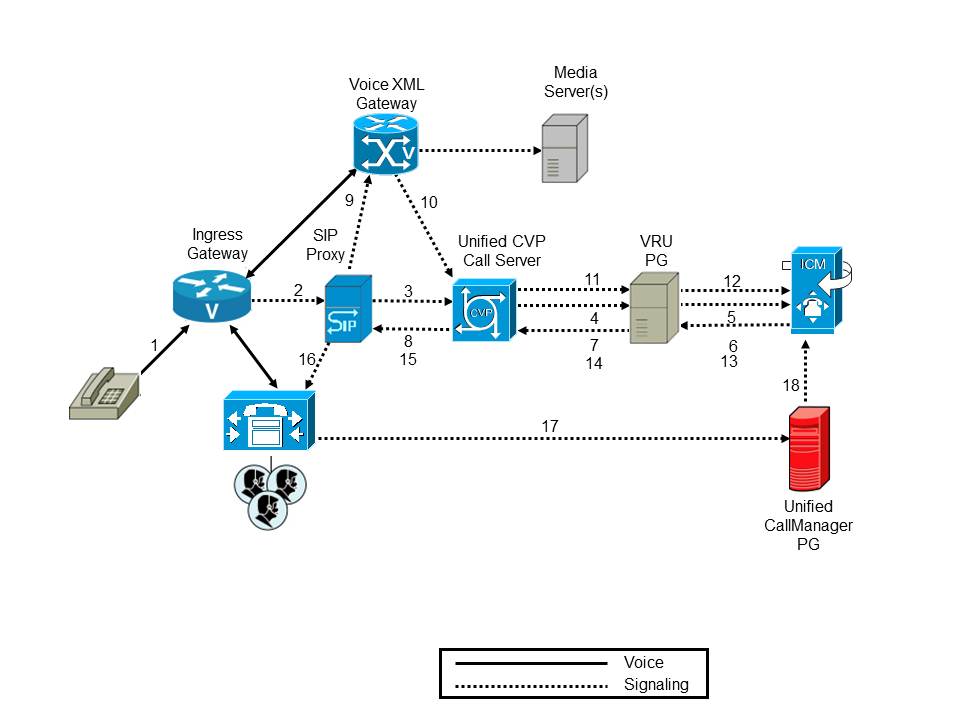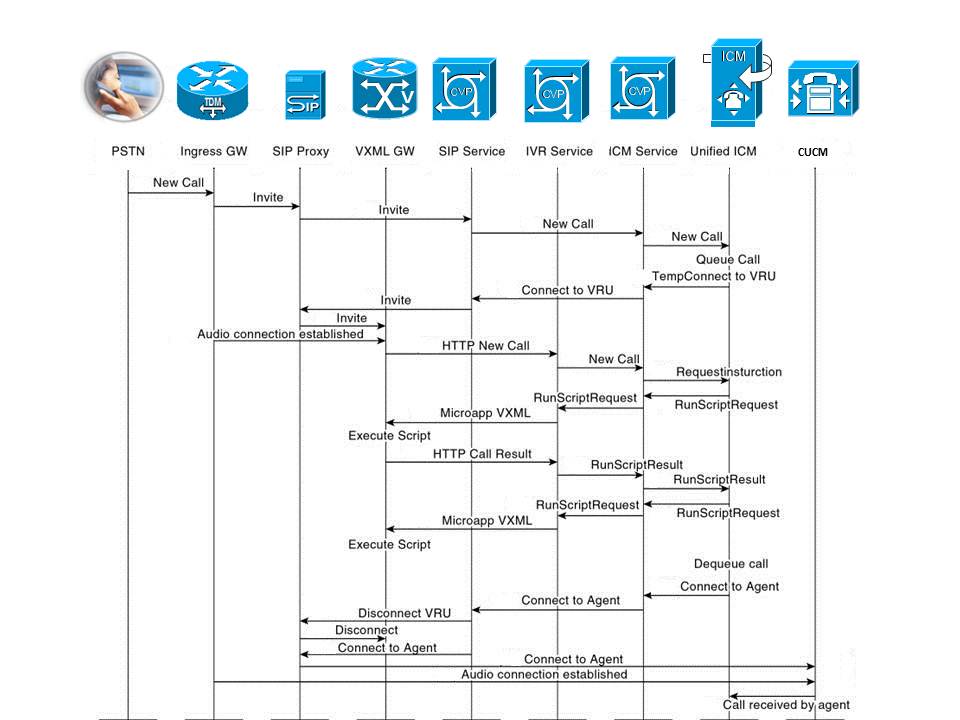- Cisco Community
- Technology and Support
- Collaboration
- Collaboration Knowledge Base
- Chalk Talk: Examining Unified Customer Voice Portal’s Comprehensive Call Flow with SIP
- Subscribe to RSS Feed
- Mark as New
- Mark as Read
- Bookmark
- Subscribe
- Printer Friendly Page
- Report Inappropriate Content
- Subscribe to RSS Feed
- Mark as New
- Mark as Read
- Bookmark
- Subscribe
- Printer Friendly Page
- Report Inappropriate Content
on 01-11-2012 10:12 AM
This Comprehensive deployment model provides organizations with a mechanism to route and transfer calls across a VoIP network, offers IVR services, and queues calls before routing to a selected agent. These features are usually found in situations in which an organization is interested in providing a pure IP-based contact center. A caller can initially be directed into an IVR service, exit, and be queued for the next available agent. In addition, transfers are supported between Unified CCE Agents. The passing of data between Unified CVP and ICM is fully supported, and cradle-to-grave reporting for all calls is also supported. Figure 1 defines the components used with this model and their protocols.

Figure 1: Unified CVP Comprehensive Functional Deployment Model
Table 1 provides which components are requires, optional, and not used by this model. In addition, the Native column identifies components native to the Unified CVP solution:
Table 1 Unified CVP Comprehensive Native and Non-Native Component Usage
Component | Required | Optional | Not Used | Native |
SIP Service (Call Server) | Yes | — | — | Yes |
IVR Service (Call Server) | Yes | — | — | Yes |
ICM Service (Call Server) | Yes | — | — | Yes |
H323 Service (Call Server) | Yes (If H323) | — | — | Yes |
VoiceXML Server | — | Yes | — | Yes |
Unified Call Studio | — | Yes | — | Yes |
Ingress Gateway | Yes | — | — | — |
VXML Gateway | Yes | — | — | — |
SIP Proxy | — | Yes | — | — |
Gatekeeper | Yes (If H323) | — | — | — |
Operations Console | Yes | — | — | Yes |
Reporting Server | — | Yes | — | Yes |
ASR/TTS | —— | Yes | — | — |
Media Server | Yes | — | — | |
DNS Server | — | Yes | — | — |
Content Services Switch | — | Yes | — | — |
Unified ICM | Yes | — | — | — |
Unified Communications Manager | — | Yes | — | — |
Egress Gateway | — | Yes | — | — |
The following section examines the detailed call flow steps performed in a typical comprehensive call flow. As its name indicates this model is the most complex from a call flow perspective. Figure 2 illustrates a typical comprehensive call flow with a SIP proxy server as part of the solution.

Figure 2: Unified CVP Comprehensive SIP Call Flow with a SIP Proxy Server
Following are the details for the steps previously referenced:
- The call arrives from either the PSTN or a VoIP connection to the gateway.
- The Ingress Gateway sends a SIP INVITE message the SIP Proxy Server.
- The SIP Proxy Server forwards this SIP INVITE to the Unified CVP Server's SIP Service.
- The SIP Service sends a new call request to Unified ICM via the Unified CVP Server ICM Service and the PG.
- The Unified CVP Server sends Unified ICM a new call request via its VRU PIM that is configured and hosted by the PG. This new call request invokes a routing script in Unified ICM based on the dialed number provided by Unified CVP.
- The Unified ICM routing script determines that the caller must be transferred to the VRU and passes a Connect to VRU request to the PG, which will be forwarded to the ICM Service on the Unified CVP Call Server.
- PG passes the information provided in Step 6 to the ICM Service on the Unified CVP Call Server.
- Invitation to Connect to VRU goes from SIP Service back to the SIP Proxy Server requiring the SIP Proxy Server to determine which VXML Gateway based on its routing table should handle the Connect to VRU and subsequent call treatment session for the VRU leg of the call.
- Invitation (including information about Ingress Gateway) is sent from the SIP Proxy Server to a VXML Gateway, which then connects the audio path back to the Ingress Gateway.
- The VRU label causes the VXML Gateway to fire off an application dial-peer, which starts the VRU or application leg of the call. The VXML Gateway connects to the Unified CVP Call Server via HTTP and requests instructions for treating the connected call. This HTTP new call request is handled by the Unified CVP Server's IVR Service, which then passes this request to the Unified CVP Server's ICM Service.
- ICM Service sends Request Instructions to Unified ICM via the PG.
- Unified ICM continues the script that was started in Step 5 and processes additional nodes that produce Run Script requests to the Unified CVP Server's ICM Service. It hands these instructions over to the Unified CVP Server's IVR Service that converts them into VXML pages that are forwarded back to the VXML Gateway for rendering and execution. This process can also include prompt and collect instructions and continues between Unified ICM, Unified CVP, and the VXML Gateway until an agent becomes available. The VoiceXML Gateway also fetches any media files requested in the VXML pages from the media server (refer to the top of Figure 3-12).
- The agent becomes available so Unified ICM dequeues the call and asks to be disconnected from the VXML Gateway. Unified ICM passes a connect-to-agent request to the Unified CVP Server's ICM Service via the VRU PG.
- PG passes the information provided in Step 13 to the ICM Service on the Unified CVP Call Server. The ICM Service passes this connect request to the Unified CVP Server's SIP Service.
- The Unified CVP Server's SIP Service passes this VRU disconnect request to the SIP Proxy Server.
- The SIP Proxy Server passes a disconnect message to the VXML Gateway. SIP Service passes a connect-to-agent request to the SIP Proxy Server. The SIP Proxy Server passes this connect-to-agent request back via a SIP INVITE to the Cisco Unified Communications Manager Subscriber server responsible for handling the configured SIP Trunk. Because the audio path was tore down between the Ingress Gateway and the VXML Gateway, a new one is established between the Ingress Gateway and the Unified CCE Agent IP Phone hosted on the CUCM cluster.
- Unified Communications Manager informs the PG that a call was delivered to a Unified CCE Agent.
- PG notifies Unified ICM that a call has been delivered to the Unified CCE Agent.
SIP Call Flow Ladder Diagram
Figure 3 illustrates this model's call flow, which provides details on how comprehensive it truly is.

Figure 3: Unified CVP Comprehensive SIP Call Flow Ladder Diagram
Conclusion
In this article we took a close look at Unified CVP’s comprehensive call flow with SIP. While there are other deployment models supported by Unified CVP, there is only one that is truly comprehensive, bearing the name. In order to deploy and troubleshoot Unified CVP, it is critical to completely understand its call flows and the native and non-native components utilized.
Rue Green, CCIE No. 9269, is a Technical Leader for the Customer Collaboration Service Line within Cisco Advanced Services focusing on Unified Contact Center architectures and deployment methodologies. He currently acts in a delivery architect role over sighting deployment architectures for Unified CVP, Unified ICM, and Cisco Unified Communications Manager for Unified Contact Center Solutions. Rue has spent the last 21 years working within different roles covering software development to network architecture, design, and implementation for large voice and data networks. Rue has a B.S. degree in computer science and mathematics from Colorado Mesa University. He is also a dual Cisco Certified Internetwork Expert (CCIE #9269) in Routing & Switching and Voice, and a Certified Information System Security Professional (CISSP #75393). He also carries many other vendor and industry certifications such as the Microsoft Certified Systems Engineer with Exchange 2003 emphasis and the newer Microsoft Certified IT Professional: Enterprise Administrator certification on Server 2008.
Cisco Unified Customer Voice Portal: Building Unified Contact Centers
By Rue Green
Published by Cisco Press.
Published: Dec 19, 2011
ISBN-10: 1-58714-290-2
ISBN-13: 978-1-58714-290-1
- Mark as Read
- Mark as New
- Bookmark
- Permalink
- Report Inappropriate Content
After a long time atleast someone wrote a book on CVP. bravo.
- Mark as Read
- Mark as New
- Bookmark
- Permalink
- Report Inappropriate Content
I agree 100%, it was long over due. I hope you enjoy it as much as I did putting it together.
Cheers!
Find answers to your questions by entering keywords or phrases in the Search bar above. New here? Use these resources to familiarize yourself with the community: